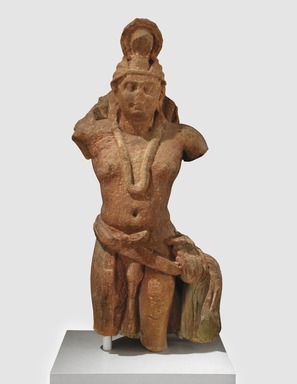
Medium: Sandstone
Geograhical Locations:
Dates:1st–2nd century
Dimensions: 47 x 18 x 10 3/8 in., 364 lb. (119.4 x 45.7 x 26.4 cm, 165.11kg) Object on mount: 54 x 24 x 16 in. (137.2 x 61 x 40.6 cm)
Collections:
Museum Location: Asian Galleries, Arts of South Asia, 2nd floor
Accession Number: 67.202
Image: 67.202_edited_SL1.jpg,
Catalogue Description: The figure represents a serpent king standing with slightly spread legs. He wears a skirt-like dhoti, but characteristic of the Mathura style, the cloth is apparent only at the hem as it crosses beneath the knees and in the folds falling between the legs. His cloth girdle falls over the left leg, and a dupatta is tied in a large loop behind his left hip. He is also ornamented with a necklace and earrings and high headdress. A cobra body with expanding hood rises up the back of his body as a tail. Nagas were semi-divine beings having a human face with the tail of a serpent and the expanded beck of the cobra. The race of Nagas is said to be a thousand in number and to have spring from Kadru, the wife of Kasyapa, for the purpose of peopling Patala or the regions below the earth where they reign in great splendor. From the name of their mother they are called Kadraveyas. The dominion of Patale was taken from them by the Gandharas, but the Nagas recovered it through their sister, the Marmada River, who induced Vishnu to send Pratardana to their assistance. The Nagas, or people bearing the same name, are historical and have left many traces behind them. There were mountains so called, and Naga-dwipa was one of the seven divisionsof Bharata-varsha. Kings of this race reigned at Mathura, Padmavati, etc., and the name survives in the modern Nagpur. There are various speculations as to who and what they were, but it seems clear they were a race distinct from Hindus. The mythological accounts are probably based upon the historical, but they have mixed up together and are confused. One theory is that they were a Scythic race and probably obtained their name from worshipping serpents or holding them in awe and reverence. When Buddha began to preach he is said to have converted the Nagas who then became devoted followers and protectors. This figure was undoubtedly associated with the Buddhist rather than the Hindu pantheon since it was excavated near Mathura in association with other Buddhist images. Condition: Surface of stone badly weathered with obvious flaking and scaling of the stone. Feature of face particularly worn, but general condition good.